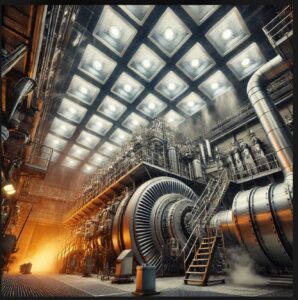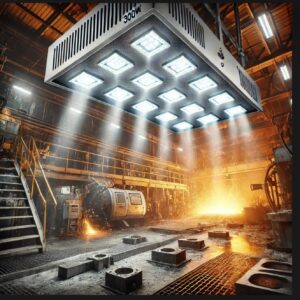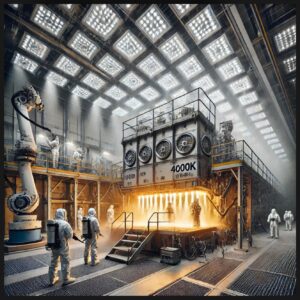4. Focused or Area-Wide Lighting for Task Optimization
- Task-Specific Lighting: Glass production areas often include different tasks that require specific lighting setups. Some tasks may require highly focused lighting, while others require broad, diffused illumination.
-
- Focused Lighting: For tasks like cutting, shaping, or inspection, focused lighting with adjustable beam angles allows workers to direct light precisely where needed. This helps enhance visibility and detail, ensuring tasks are completed with maximum accuracy.
- Area-Wide Lighting: In areas where workers are moving materials or managing large sections of the production line, area-wide lighting that covers a broader space may be required. Adjustable beam angles or modular lighting systems allow for the installation of fixtures that can be tailored to the size of the area being lit.
- Modular Lighting Systems: Many advanced industrial LED lighting systems are designed to be modular, meaning they can be added or adjusted to provide the right light coverage based on the specific requirements of the production environment. This modularity ensures that every section of the glass production line receives optimal light.
5. Energy Efficiency with Customizable Lighting
- Adjusting to Task Load: Customizable light output can also contribute to energy savings by reducing the lighting intensity when full brightness is not required. For example, during non-production hours or when a specific task doesn’t require high-intensity lighting, the light output can be dimmed.
- Smart Control Systems: Many modern lighting systems come with smart controls that allow for automation based on time of day, task load, or motion detection. For example, in areas where workers are not constantly present, the lighting intensity can be automatically reduced to save energy while maintaining the necessary illumination when workers are present.
- Energy-Efficient LEDs: Even when the light output is adjusted to higher levels, the energy efficiency of LEDs means that the system uses far less energy than traditional incandescent or halogen bulbs. Customizable LED lighting systems ensure that energy consumption is optimized, which reduces overall operational costs.
6. Improving Quality Control and Defect Detection
- Consistent Color Rendering for Accuracy: High-CRI (Color Rendering Index) LED lights with customizable output allow workers to see the true colors of glass surfaces, making it easier to spot defects, bubbles, or surface imperfections.
- Task-Specific Color Adjustment: Some advanced LED systems allow users to customize not only the intensity but also the color spectrum, which can be important in industries like glass production where different stages of the process might require slightly different light characteristics to highlight particular aspects of the material.
Customizable light output in high-temperature LED lighting systems plays a pivotal role in optimizing visibility across the different stages of glass production. By adjusting light intensity, color temperature, and beam distribution, manufacturers can create ideal lighting conditions for each task, improving worker safety, product quality, and operational efficiency. These flexible lighting solutions not only enhance visual comfort and precision but also contribute to energy savings and reduced operational costs, making them a smart investment for any glass manufacturing facility.

V. Implementation of LED Lighting in Float Glass Factories
Strategic placement for optimal illumination and efficiency
In glass production environments, proper lighting placement is key to ensuring optimal illumination while maintaining energy efficiency. Glass manufacturing involves several stages that require different lighting conditions, and strategic placement of lighting fixtures helps ensure that workers have the right visibility for each task. By considering factors like workspace layout, light distribution, and task-specific requirements, manufacturers can maximize both the effectiveness and efficiency of their lighting systems. Here’s how strategic placement contributes to optimal illumination and energy efficiency:
1. Identifying Key Areas Requiring Illumination
- High-Precision Workstations: Areas where workers perform tasks like cutting, inspection, or shaping glass need focused, high-intensity lighting to ensure visibility of every detail. By placing lights directly above or around these workstations, manufacturers can provide task-specific illumination that enhances productivity and safety.
- General Work Areas: For areas where workers are performing less detailed tasks or moving materials, a more uniform and diffuse light source is required. Strategic placement of broad, even lighting fixtures ensures that the entire workspace is illuminated, preventing shadows and dark spots that could hinder movement and visibility.
- Machinery and Conveyor Belts: Lighting fixtures should be placed above or along the production line, ensuring that both the workers and machinery are illuminated properly. This is crucial for monitoring the operation of equipment, preventing accidents, and ensuring that all tasks are performed smoothly.
2. Maximizing Light Distribution and Minimizing Glare
- Even Light Distribution: To avoid concentrated spots of light that could cause glare, lighting fixtures should be strategically placed to provide uniform distribution. For example, multiple fixtures can be spread across the ceiling or walls to provide balanced lighting across the production floor. This approach prevents workers from straining their eyes in brightly lit areas while other spots are left in the shadows.
- Eliminating Glare: Glare from improperly placed lights can be distracting and cause eye strain, particularly in environments where workers need to focus on intricate details like inspecting glass surfaces. Anti-glare diffusers or frosted lenses can be used in areas with high-intensity lighting to ensure that the light is soft and diffused. Additionally, placing lights at the right angles, such as overhead or indirect lighting, reduces direct exposure and minimizes glare.
- Task-Specific Lighting Zones: For operations where fine details are essential, such as glass defect detection or quality control, lighting fixtures should be placed at angles that provide shadowless illumination. Positioning the lights at 45-degree angles relative to the workstation can help create a more evenly lit surface, making it easier for workers to spot defects or inconsistencies in the glass.
3. Using Modular and Adjustable Lighting Fixtures
- Modular Lighting Systems: A modular lighting system gives flexibility for customized placement in response to specific production needs. These systems can be installed in rows along the production floor or integrated into the ceiling to adapt to varying light levels for different stages of production. For example, additional lights can be added in areas where extra brightness is required during inspection, or dimming features can be applied in less critical areas.
- Adjustable Fixtures: Adjustable, swivel-mounted LED lights allow for dynamic control over the direction of the light. This flexibility is important when production needs change or different tasks are performed in the same area at different times. With adjustable fixtures, manufacturers can reorient the lights to suit various tasks, optimizing lighting conditions and reducing unnecessary energy consumption.

4. Consideration of Ceiling Height and Light Beam Angles
- Ceiling Height and Light Placement: In industrial glass production areas, ceiling height often plays a critical role in lighting placement. For high-ceiling areas, lighting fixtures should be placed further apart to cover a larger area, or higher-powered LEDs may be required to ensure that the entire workspace is lit evenly. Conversely, for lower-ceiling areas, fixtures should be positioned closer together to maximize light coverage.
- Light Beam Angles and Spacing: The beam angle of the lighting fixtures should be chosen based on the space they need to cover. For areas where a wide area needs to be lit, fixtures with wider beam angles (e.g., 120° or more) should be used, while more focused lighting is needed for detailed tasks, requiring narrower beam angles (e.g., 30° or 45°). Strategic placement of such fixtures, combined with the correct beam angles, ensures that energy is not wasted, and every area is lit appropriately.
5. Leveraging Natural Light and Supplementing with Artificial Lighting
- Utilizing Daylight: In glass production areas with large windows or open structures, natural daylight should be utilized to reduce dependence on artificial lighting. Strategic placement of lighting fixtures around natural light sources can help maintain proper brightness during the day while reducing overall energy usage.
- Lighting for the Evening and Night Shifts: During evening or night shifts, when natural light is unavailable, lighting fixtures should be placed to complement the daylight setup, ensuring the same level of illumination without causing disruption to the workers. The ability to adjust light levels according to the time of day helps optimize energy usage, ensuring that artificial lights are only used when necessary.
6. Energy Efficiency Through Smart Lighting Controls
- Lighting Control Systems: Implementing smart lighting controls that can automatically adjust the lighting based on ambient light levels, occupancy, or production activity reduces unnecessary energy use. Motion sensors and occupancy sensors can be placed in areas like walkways, storage rooms, or unoccupied sections of the production floor to ensure lighting is only activated when needed.
- Dimming Features for Task-Based Lighting: Certain sections of the production line may require bright lighting during specific tasks (such as quality control) but can be dimmed when not in use. Using lighting systems that allow for remote control or automated dimming based on the tasks being performed enhances energy efficiency and lowers operational costs.
Strategic placement of lighting fixtures in glass production areas ensures that optimal visibility is maintained while maximizing energy efficiency. By considering factors such as task-specific lighting needs, beam angles, glare reduction, modular systems, and smart controls, manufacturers can provide the right lighting conditions for every stage of the production process. This not only improves safety and quality control but also reduces energy consumption, ensuring that the lighting system operates efficiently and cost-effectively. The result is a well-lit, productive, and energy-efficient production environment.

Comparison of LED vs. traditional lighting in real-world applications
In industries like glass manufacturing, where precision, safety, and energy efficiency are paramount, choosing the right lighting system is crucial. LED lighting has quickly become the preferred choice in many industrial and commercial applications due to its numerous advantages over traditional lighting technologies, such as incandescent, fluorescent, and metal halide lamps. Below is a detailed comparison of LED lighting versus traditional lighting across key factors such as energy efficiency, lifespan, performance, and environmental impact.
1. Energy Efficiency
-
- Superior Efficiency: LEDs use a fraction of the energy compared to traditional lighting systems. For example, an LED that provides the same light output as a 100W incandescent bulb typically consumes only 15–20W.
- Lower Power Consumption: LEDs convert almost all the energy they consume into light, with minimal heat output. This makes them significantly more energy-efficient, reducing electricity consumption and operational costs.
- Reduced Cooling Load: Because LEDs produce much less heat than traditional lighting, they reduce the cooling load in industrial environments, leading to further energy savings on air conditioning or ventilation systems.
- Traditional Lighting (Incandescent, Fluorescent, Metal Halide):
-
- High Energy Consumption: Traditional lights, especially incandescent and metal halide lamps, use a large amount of energy, with a significant portion being wasted as heat. For example, an incandescent bulb uses about 90% of its energy to produce heat, leaving only 10% for light.
- Inefficient Operation: Fluorescent and metal halide lamps are more efficient than incandescent bulbs but still fall short compared to LEDs. Metal halide lamps, commonly used in industrial applications, are typically 25-40% less efficient than LEDs, and they also require a warm-up period before reaching full brightness.
2. Lifespan and Durability
-
- Long Lifespan: LEDs can last 25,000 to 50,000 hours depending on the application, which is significantly longer than traditional lighting. This means less frequent replacements, reduced downtime, and lower maintenance costs.
- Durability: LEDs are solid-state lights, meaning they are much more resistant to vibration, shocks, and temperature fluctuations. This makes them ideal for industrial applications where equipment is often exposed to rough handling or environmental stress.
(To Be Continued)


